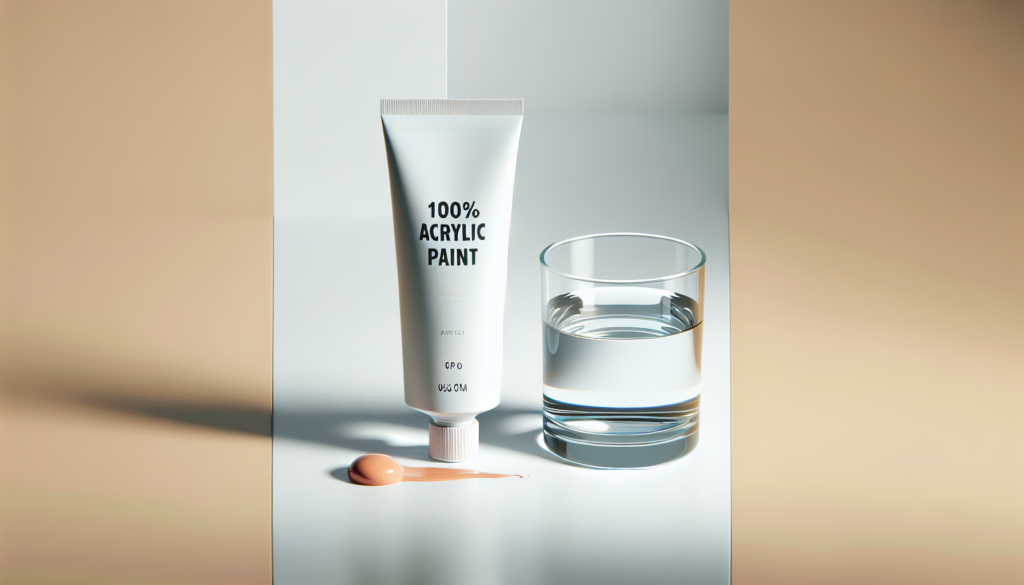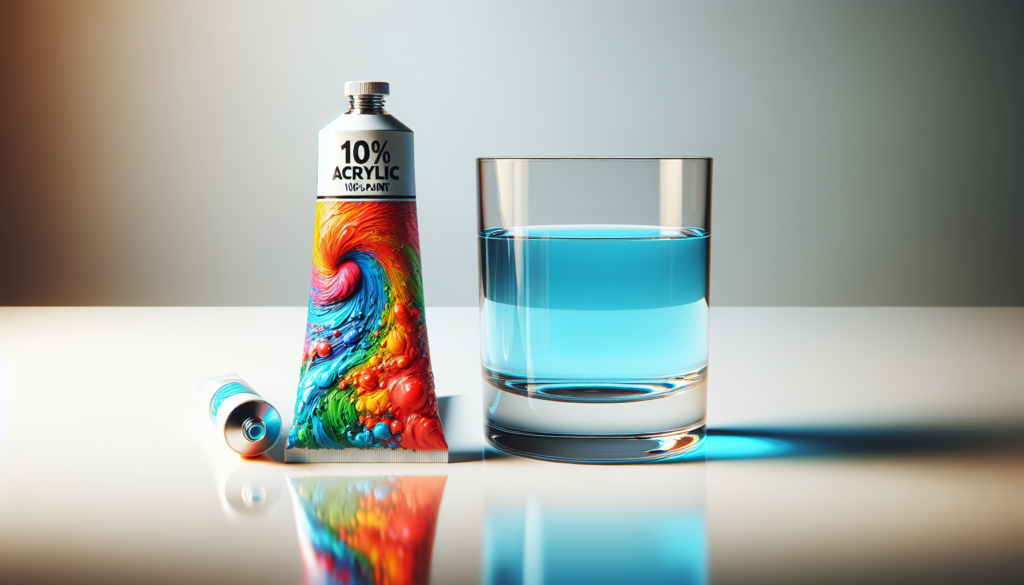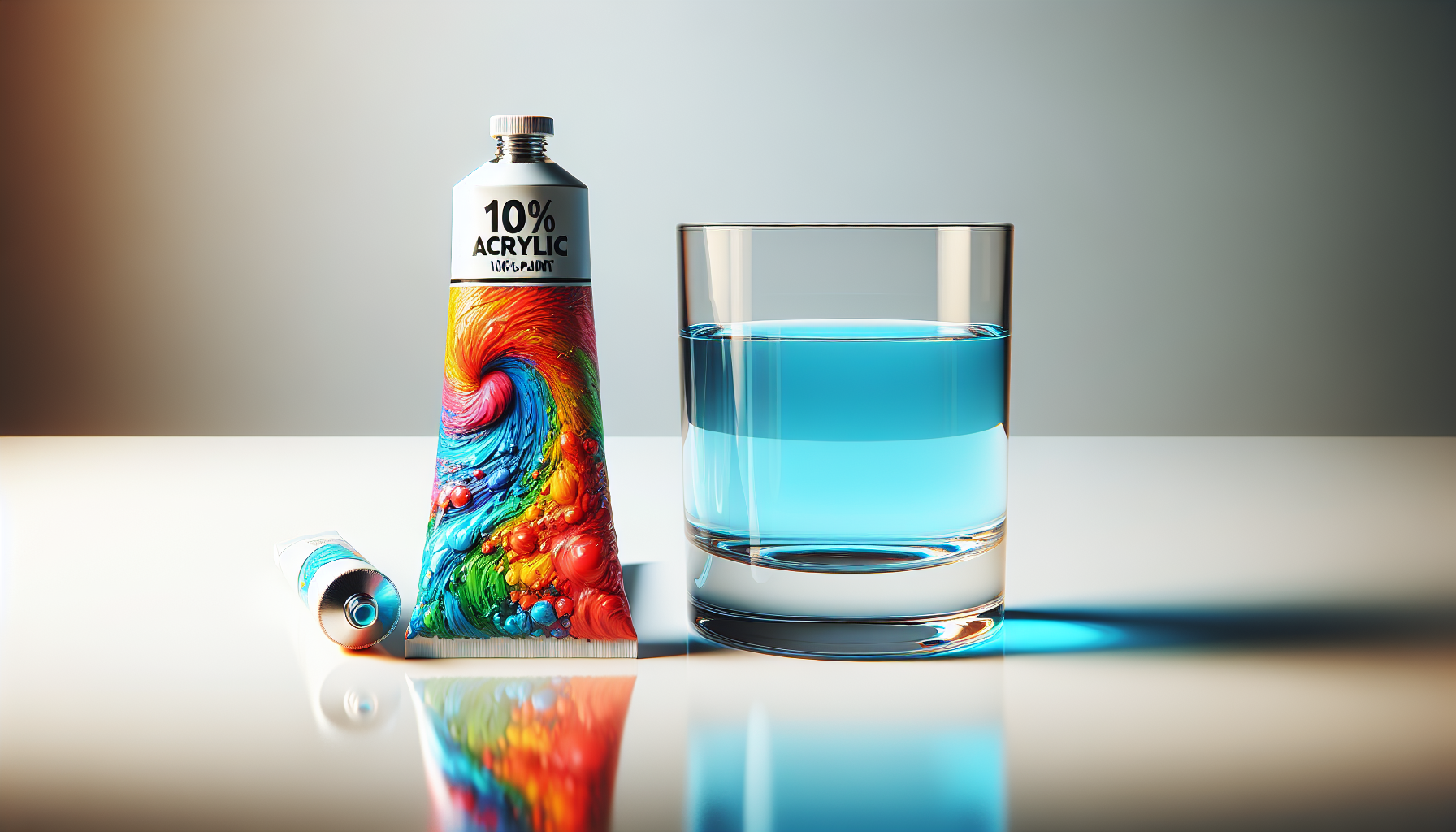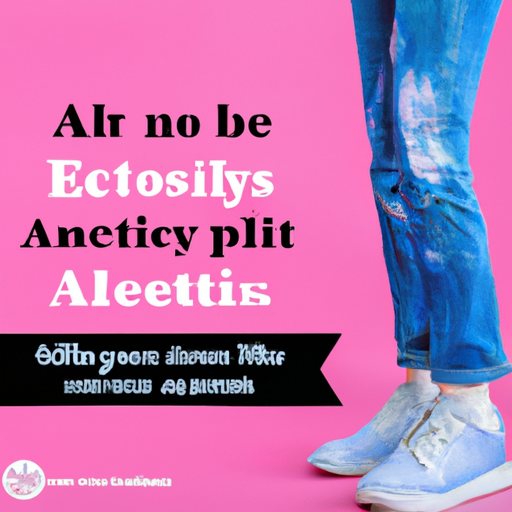In this thought-provoking article, “Is 100 Acrylic Paint Water Based,” you will find invaluable insights into the composition of 100% acrylic paint and whether or not it is water-based. As you peruse the compelling evidence presented, sharp clarity will emerge around this essential aspect of acrylic paint, equipping you with a deeper understanding of arts and crafts materials. With this knowledge, your discernment in the selection of such materials for your creative endeavors will certainly be enhanced.

What is Acrylic Paint?
Definition of acrylic paint
Acrylic paint is a popular type of paint used in both fine art and craft painting. It was first introduced in the mid-twentieth century and has since gained popularity due to its versatile properties. It’s made with pigments suspended in an acrylic polymer emulsion, which gives it its distinct characteristics.
Composition of acrylic paint
The composition of acrylic paint largely consists of pigment, binder, and a solvent. The pigment provides the color, the binder holds the pigment particles together and adheres them to the surface being painted, and the solvent, often water, helps to thin the paint and allows it to spread more easily.
Properties of acrylic paint
Acrylic paints are renowned for their quick drying time, flexibility, and durability. Once dry, acrylic paint becomes water-resistant, allowing for layering without disturbing previous layers. It also adheres well to a variety of surfaces, including canvas, paper, wood, and more. Additionally, acrylic paint is largely resistant to the damaging effects of light, making it a long-lasting choice for artworks.
Understanding Water-Based Paints
Different types of water-based paints
Water-based paints encompass a wide variety of paints, including acrylics, latex paints, tempera, and gouache. These paints are all thinned and cleaned with water rather than solvents such as turpentine or mineral spirits, a feature that brings several advantages.
Advantages of water-based paints
Water-based paints are generally more user-friendly and health-friendly than solvent-based paints. They tend not to emit toxic fumes, reducing risks associated with inhalation and exposure. Plus, their clean up is usually a breeze, only requiring water and soap.
Properties of water-based paints
These types of paints dry relatively quickly and have a minimal odor due to the absence of strong solvents. Water-based paints are also generally more environmentally friendly and are less prone to cracking over time.
What Does it Mean for Acrylic Paint to be Water Based?
Definition of water-based acrylic paint
When we speak of water-based acrylic paint, we are referring to acrylic paint that uses water as their primary solvent. In this context, the solvent is the liquid component of the paint in which the pigment is dissolved or suspended.
Why acrylic paint is considered water-based
Acrylic paint is considered water-based because the polymer emulsion in the paint is water-soluble. This means you can thin the paint with water and also use water for cleanup. Once the paint has dried, however, it becomes water-resistant.
Composition of water-based acrylic paint
The composition of water-based acrylic paint is similar to regular acrylic paint but is intentionally designed to be thinned and cleaned up with water. It’s composed of pigment, binder, and a water solvent, although it can often include additional additives to enhance certain properties.
Distinguishing Water-Based Acrylic Paint from other Acrylic Paints
Types of acrylic paint
There are several types of acrylic paint, each with their own characteristics. For instance, heavy body acrylics have a thick consistency similar to oil paint, while fluid acrylics are thinner and can be used for detail work or stained effects. There are also interactive acrylics which allow more working or blending time.
Acrylic paint brands
Numerous brands produce acrylic paints, and each brand can have its own unique formula. Some popular brands include Golden, Liquitex, and Winsor & Newton. While all these brands offer water-based acrylics, the composition and properties can slightly differ from one to another.
Differences between water-based and solvent-based acrylic paint
While all acrylic paints are technically water-based, some have been formulated to be thinned and cleaned up with solvents. Solvent-based acrylics are sometimes preferred by artists that wish for a longer drying time, deeper gloss, or more complex layering and blending effects. However, they typically require special care in handling and cleaning.

Advantages of Using Water-Based Acrylic Paint
Non-toxic and environmentally friendly
One of the main advantages of using water-based acrylic paint is that it tends to be non-toxic and environmentally friendly. The absence of harmful solvents means less toxicity and fewer environmental impacts.
Easy cleanup
Cleaning up after using water-based acrylic paint is significantly easier than with solvent-based paint. As it is water-soluble, a simple rinse under running water or a clean with soapy water is typically enough to clean your brushes and other tools.
Fast drying time
Water-based acrylic paint typically dries quickly due to the evaporation of water. This allows artists to apply multiple layers in a short amount of time, which can be beneficial for certain styles and techniques.
Disadvantages of Water-Based Acrylic Paint
Less durable compared to solvent-based acrylic paint
While water-based acrylic paint is known for its durability, it can sometimes be less durable than its solvent-based counterparts, especially in outdoor applications where it may be more vulnerable to weather conditions.
Limited color range
Another disadvantage of water-based acrylic paint may be a limited color range. While improvements are continually being made, solvent-based paints can sometimes offer more vibrant and saturated colors.
Can affect texture and consistency of paint
Water-based acrylic paint can also affect the texture and consistency of the paint. As water is added, the paint can become thinner, which may not be ideal for artists seeking a heavy body or highly textured effect.
How is 100% Acrylic Paint Different?
Definition of 100% acrylic paint
100% acrylic paint refers to paint in which the binder is composed entirely of acrylic polymer. In other words, it contains no extenders or fillers and provides superior adhesion and durability.
Composition of 100% acrylic paint
The composition includes pigment for color, 100% acrylic polymer as the binder, and water as the solvent. Like other acrylic paints, it may also include additives to enhance the paint’s performance and ease of application.
Properties of 100% acrylic paint
100% acrylic paint offers excellent color retention, adhesion, and durability. Its water resistance upon drying is superior, reducing the risk of cracking and peeling. Moreover, it is highly flexible, allowing it to withstand temperature changes and movement without compromising its integrity.
Is 100% Acrylic Paint Water Based?
Clarifying the term
The term “100% acrylic” refers to the type of binder used in the paint, not the solvent. Therefore, a 100% acrylic paint can be water-based, meaning it uses water as its primary solvent.
Debunking misconceptions
There can be confusion around this point because people often associate “100% acrylic” with solvent-based products. However, the “100% acrylic” descriptor is about the binder and makes no direct implication about the solvent used.
Explanation of water-based components in 100% acrylic paint
As with other acrylic paints, 100% acrylic paint is made with a water-soluble polymer. This means that, while the paint contains 100% acrylic polymer as its binder, water is still used as the solvent, qualifying it as water-based.
Comparing 100% Acrylic Paint to Water-Based Acrylic Paint
Similarities between 100% acrylic and water-based acrylic paint
Both 100% acrylic and other water-based acrylic paints have water as a solvent and use an acrylic polymer as a binder. They’re both known for their fast drying times and can be cleaned up using water.
Differences between 100% acrylic and water-based acrylic paint
The main difference lies in the fact that 100% acrylic paint does not use any fillers or extenders in its binder, which can enhance its overall performance and durability.
Conclusion
Understanding the water-based nature of acrylic paint
Understanding the water-based nature of acrylic paint can equip you with the knowledge to select the right type of paint for your needs. While all acrylic paints are water-soluble to some degree, not all are designed to be thinned and cleaned up with water.
Choosing the right acrylic paint
Ultimately, the right acrylic paint for you will depend on your specific needs and preferences. Consider what you value most in a paint – be it durability, ease of use, environmental impact, or drying time – to inform your choice. By understanding the properties of each type, you can select the right paint for your project.



